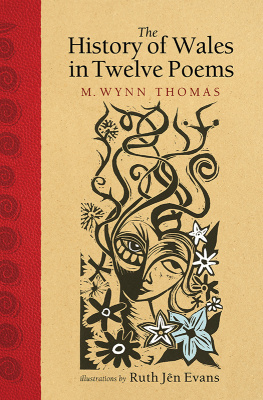
This book is dedicated to all the people of Wales.
Without their unwavering commitment
to oddness and peculiarity,
this book would never have been written.
Contents
There is a story which may not be true. It might only be an urban myth, which would be a great shame because it deserves to be a true slice of life. It tells of a man in some versions it is the actor Anthony Hopkins who takes a cab in New York.
Where are you from? asks the driver.
Wales.
And Wales is what exactly? A big fish, Dianas husband or them singing bastards?
A tough choice, I think. But what this book intends to show is that the Welsh are not all singing bastards.
Some are a whole lot worse.
On Tour
Neanderthal remains have been found in Pontnewydd Cave in Denbighshire, near St Asaph. They were dated in 1981 and were confirmed as being about 230,000 years old the oldest remains ever uncovered in Wales. A total of nineteen teeth were found, coming from five different individuals, both children and adults. One piece of jawbone holding a milk tooth and a permanent molar are believed to have come from an 11-year-old boy. There were also some stone tools and animal bones in the cave.
The teeth could, of course, be all that is left of an ancient burial site, scoured in the intervening millennia by retreating ice sheets. They had been there an awfully long time. Alternatively, it was the site of an early dental clinic.
Neanderthals are a particular branch of the evolutionary tree and one of natures less attractive experiments. We shared a common ancestor with them but did not evolve from them. They had sloping foreheads, large brow ridges, big square jaws, short limbs, and they were pug-ugly. They were hunters who needed to get close to their prey in order to catch them, since they do not appear to have developed the use of weapons. They must have attacked in packs, showing a level of co-operation and planning. Other remains found elsewhere show signs that their hunting style left some of them with broken limbs. They did, however, use simple stone tools to butcher their meat.
 A stone hand axe found in Rhosili was made by a Neanderthal craftsman about 100,000 years ago.
A stone hand axe found in Rhosili was made by a Neanderthal craftsman about 100,000 years ago.
 The earliest inhabitants of Cardiff left behind the Pen-y-Lan hand axe, dating from 75,000 BC .
The earliest inhabitants of Cardiff left behind the Pen-y-Lan hand axe, dating from 75,000 BC .
 The hardest and most time-consuming part of making an axe head was boring a hole all the way through the stone or flint for a handle, using only wood, stone and sand.
The hardest and most time-consuming part of making an axe head was boring a hole all the way through the stone or flint for a handle, using only wood, stone and sand.
 In 2006 a professor from Oxford University suggested that bachelor twins from Strata Florida were the last carriers of the Neanderthal bloodline. Every year children from Tregaron School were taken up to meet them as part of their study of evolution. Sadly the twins left no photographs.
In 2006 a professor from Oxford University suggested that bachelor twins from Strata Florida were the last carriers of the Neanderthal bloodline. Every year children from Tregaron School were taken up to meet them as part of their study of evolution. Sadly the twins left no photographs.
All this evidence points inevitably to one conclusion. Teeth scattered everywhere? Broken limbs? Close-proximity fighting? A distinctive evolutionary branch? The Neanderthal party that left their teeth in Pontnewydd were nothing more complicated than a rugby team on tour who were looking for the local sport injuries clinic.
c. 27,000 BC Paviland, Gower
The Red Lady of Paviland
Lets get one thing straight before we start. The Red Lady of Paviland was no lady. She was a man.
Bones, believed to be those of elephants, had been found in December 1822. The discovery brought William Buckland, Professor of Geology at Oxford University, to the site in Goats Hole in January 1823 and he unearthed the remains of an incomplete skeleton, stained red. The bones were from the right side of the body. The other bones that must have been there were probably disturbed by the action of the sea over the centuries. The area around the body, along with the bones themselves, was stained red. So were the items buried with the body mammoth ivory bracelet fragments and perforated periwinkle shells. There were also small limestone blocks that may have been placed at the head and feet. Perhaps the skull of a mammoth found nearby may have also been part of the burial ritual. Sadly the skull has since been lost.

When Buckland published his findings later in the year he had decided that the ochre-stained skeleton was a painted lady who entertained the Roman soldiers garrisoned in the camp on the hill above the cave. Alternatively, she could have been a witch.
The problem was Buckland was entirely wrong: the burial was male, and the mammoth products were original and Palaeolithic and not manufactured in some way at a later date as decorations. The camp was Iron Age, not Roman.
We now believe that the Red Lady was a ceremonial Palaeolithic burial dating from about 27,000 BC . The Red Lady was a healthy young adult male, aged between 25 and 30, about 5ft 6in tall and weighing about 11 stones. The head of the Red Lady has never been found, though it may have been removed as part of a burial ritual. There are other examples of this in similar graves from the period.
The find, though, was enormously significant. The Red Lady was the first human fossil found anywhere in the world and is still the oldest ceremonial burial uncovered in Western Europe.
 William Buckland found it very hard to date his prehistoric find in Paviland with any accuracy. He refused to believe that anything could pre-date the notional date of Noah and the Great Flood.
William Buckland found it very hard to date his prehistoric find in Paviland with any accuracy. He refused to believe that anything could pre-date the notional date of Noah and the Great Flood.
c. 12,000 BC Llandudno
Mr Kendricks Mandible
Thomas Kendrick had been employed in the local copper mines in Llandudno as a stonemason, but by 1880 he had retired and was working as a lapidary, making cheap jewellery from seaside pebbles. Even in the nineteenth century the idea of taking home meaningless souvenirs from the seaside was well established, and Mr Kendrick was eager to do whatever he could to relieve tourists of their unwanted cash.
He was working in his garden at his house Ardwy Orme on the Great Orme, clearing a small natural cave in order to extend his workshop. The cave was about 50ft deep and 16ft wide. Whilst the view from his garden of the promenade below him was impressive, it would soon pale into insignificance in comparison with what he discovered in the cave. Because he uncovered a significant treasure of prehistoric art, including a decorated horse jaw with three remaining incisor teeth, the oldest piece of portable art from Wales ever discovered.
The cave was probably a burial site. There were flint artefacts, animal teeth which had been pierced to use as jewellery, eight types of mollusc and human bones from three adults and a teenager. They had been nomadic hunters, probably from mainland Europe. The objects buried with them appear to have been coloured with ochre, just like those from Paviland. The find dated from about 12,000 BC . The jaw was decorated with zigzag lines and disappeared for a long time, until it was delivered to the British Museum in 1959.
Further discoveries were made in the twentieth century when the cave was excavated again, but the fear has always been that other objects were lost in earlier times. In this way the contents of the cave always give a tantalising and frustrating hint of the treasures that once might have been there.
Next page







